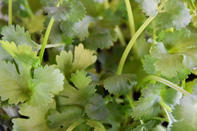
Yield - Tonnes per hectare per year
Conservative
Fresh: 4 tonnes
Dry seeds: 0.5 tonnes
Oil: 40 litres
Average
Fresh: 8 tonnes
Dry seeds: 1 tonnes
Oil: 75 litres
Good
Fresh: 12 tonnes+
Dry seeds: 1.2 tonnes
Oil: 100 litres
Harvesting
Harvesting of most commercial coriander is done mechanically. On smaller production units and in greenhouses it can be done by hand although this does get expensive.
Fresh production: start harvesting the leaves in the morning when the temperature is still cool but the leaves have dried. Harvesting of the outer leaves can start as early as 4 weeks after planting of the seeds. Bigger commercial growers will wait longer and harvest the entire bunch just before flower, cutting the bunch off about 5 cm above the ground and making bunches of the desired size. If done by hand the entire plant is pulled and packaged.
Dry seed production: For dried coriander production, wait until after flower, when the fruits start to harden and dry. The seeds are normally mature between 15 and 18 weeks from planting. The seeds are then separated from the husks and can then be sorted for replanting material and for the spice trade.
Essential oil production: The essential oils are obtained from steam distilling the crushed seeds. Of the raw material weight that is distilled, the essential oil yield represents only about 0.6 % to 1% of this.
Storage
Fresh production: After harvesting, store fresh coriander at 1°C. The coriander can be stored for about 2 to 3 weeks. The most important consideration is to keep the leaves dry in sealed containers. Fresh herbs lose their culinary flavour fast, so it is best to market and use fresh cut coriander as quickly as possible. Fresh coriander can be kept in airtight bags in a freezer.
Dry production: The dried seeds are packaged in airtight containers as soon as possible so they retain their flavour. These can be stored for nine months to a year.
Essential oil: Bottled essential oils can be stored in a dry, dark and cool space for about a year to 18 months after bottling. After this most essential oils start to lose their potency and odour.
Pests
Aphids, Army worms, Cut worms, Nematodes, Spider mite, Thrips and White fly are some common pests.
Diseases
Bacterial leaf spot, CMD Virus, Fusarium Wilt, Powdery mildew, Root rots and Soft rot.
It is best to follow a crop protection regime as prescribed by an extension officer or agronomist. The local chemical salesmen generally have the right programmes or could provide information as to the best advisors available in close proximity to the production area.